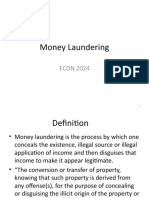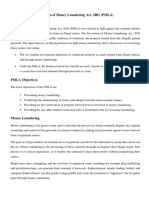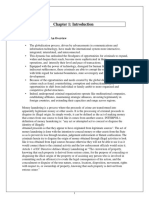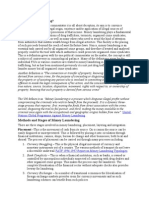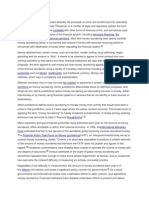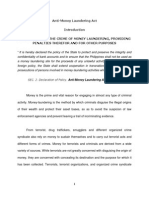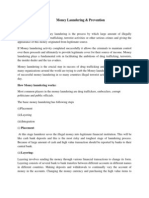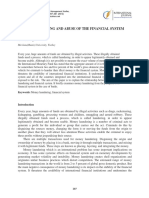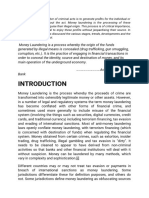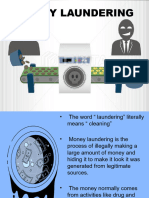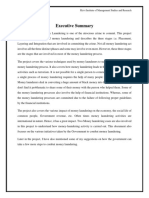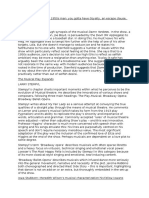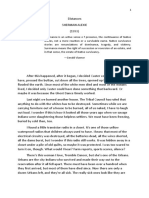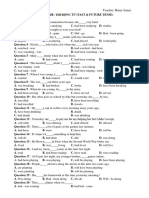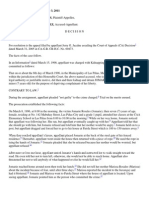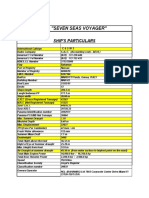1. What is Money Laundering?
Money laundering can be defined in a number of ways. But the fundamental concept
of Money laundering is the process by which proceeds from a criminal activity are
disguised to conceal their illicit origins. Most countries subscribe to the definition
adopted by the United Nations Convention against Illicit Traffic in Narcotic Drugs
and Psychotropic Substances (the Vienna Convention, 1988) and the United Nations
Convention against Transnational Organized Crime (the Palermo Convention,
2000). The definition of money laundering as per the above UN Convention is as
follows:
The conversion or transfer of property, knowing that such property is derived
from any offense, e.g. drug trafficking, or offenses or from an act of participation
in such offense or offenses, for the purpose of concealing or disguising the illicit
origin of the property or of assisting any person who is involved in the
commission of such an offense or offenses to evade the legal consequences of his
actions;
The concealing or disguising of the true nature, source, location, disposition,
movement, rights with respect to, or ownership of property, knowing that such
property is derived from an offense or offenses or from an act of participation in
such an offense or offenses, and;
The acquisition, possession or use of property, knowing at the time of receipt that
such property was derived from an offense or offenses or from an act of
participation in such offense or offenses.
According to the Section 2 of the Money Laundering Prevention Act, 2012 - “Money
Laundering” means –
1
�(i) knowingly move, convert, or transfer proceeds of crime or property involved in
an offence for the following purposes:
(1) concealing or disguising the illicit origin/nature, source, location, ownership
or control of the proceeds of crime; or
(2) assist any person for evading the legal consequences of his or her action who
is involved in the commission of the predicate offence;
(ii) smuggle funds or property abroad earned through legal or illegal means;
(iii) knowingly transfer or remit the proceeds of crime into or out of Bangladesh with
the intention of hiding or disguising its illegal source;
(iv) conclude or attempt to conclude financial transactions in such a manner as to
avoid reporting requirement under this Ordinance.
(v) convert or movement or transfer property with the intention to instigate or assist
the carrying out of a predicate offence;
(vi) acquire, possess or use property, knowing that such property is the proceeds of
a predicate offence; or
(vii) perform such activities so that illegal source of the proceeds of crime may be
concealed or disguised; or
(viii) participate in, associate with, conspire to commit, attempt to commit or abet,
instigate or counsel to commit any offences mentioned above.
2. The reasons of committing Money Laundering:
Criminals engage in money laundering for three main reasons:
First, money represents the lifeblood of the organization that engages in criminal
conduct for financial gain because it covers operating expenses, replenishes
inventories, purchases the services of corrupt officials to escape detection and further
the interests of the illegal enterprise, and pays for an extravagant lifestyle. To spend
2
�money in these ways, criminals must make the money they derived illegally appear
legitimate.
Second, a trail of money from an offense to criminals can become incriminating
evidence. Criminals must obscure or hide the source of their wealth or alternatively
disguise ownership or control to ensure that illicit proceeds are not used to prosecute
them.
Third, the proceeds from crime often become the target of investigation and seizure.
To shield ill-gotten gains from suspicion and protect them from seizure, criminals
must conceal their existence or, alternatively, make them look legitimate.
3. Why we must combat Money Laundering
Money laundering has potentially devastating economic, security, and social
consequences. Money laundering is a process to making crime worthwhile. It
provides the fuel for drug dealers, smugglers, terrorists, illegal arms dealers,
corrupt public officials, and others to operate and expand their criminal
enterprises. This drives up the cost of government due to the need for increased
law enforcement and health care expenditures (for example, for treatment of drug
addicts) to combat the serious consequences that result.
Money laundering diminishes government tax revenue and therefore indirectly
harms honest taxpayers. It also makes government tax collection more difficult.
This loss of revenue generally means higher tax rates than would normally be the
case if the untaxed proceeds of crime were legitimate. We also pay more taxes
for public works expenditures inflated by corruption. Those of us who pay taxes
pay more because of those who evade taxes. So we all experience higher costs of
living than we would if financial crime— including money laundering—were
prevented.
3
� Money laundering distorts asset and commodity prices and leads to misallocation
of resources. For financial institutions it can lead to an unstable liability base and
to unsound asset structures thereby creating risks of monetary instability and even
systemic crises. The loss of credibility and 13 investor confidence can bring the
potential of destabilizing financial systems, particularly in smaller economies.
One of the most serious microeconomic effects of money laundering is felt in the
private sector. Money launderers often use front companies, which comingle the
proceeds of illicit activity with legitimate funds, to hide the ill-gotten gains. These
front companies have access to substantial illicit funds, allowing them to
subsidize front company products and services at levels well below market rates.
This makes it difficult, if not impossible, for legitimate business to compete
against front companies with subsidized funding, a situation that can result in the
crowding out of private sector business by criminal organizations.
Among its other negative socioeconomic effects, money laundering transfers
economic power from the market, government, and citizens to criminals.
Furthermore, the sheer magnitude of the economic power that accrues to
criminals from money laundering has a corrupting effect on all elements of
society.
Nations cannot afford to have their reputations and financial institutions tarnished
by an association with money laundering, especially in today's global economy.
Money laundering erodes confidence in financial institutions and the underlying
criminal activity, such as fraud, counterfeiting, narcotics 14 trafficking, and
corruption, weaken the reputation and standing of any financial institution.
It is generally recognized that effective efforts to combat money laundering
cannot be carried out without the co-operation of financial institutions, their
supervisory authorities and the law enforcement agencies.
4
�4. Stages of Money Laundering
There is no single method of laundering money. Methods can range from the
purchase and resale of a luxury item (e.g. a house, car or jewelry) to passing money
through a complex international web of legitimate businesses and 'shell' companies
(i.e. those companies that primarily exist only as named legal entities without any
trading or business activities). There are a number of crimes where the initial
proceeds usually take the form of cash that needs to enter the financial system by
some means. Bribery, extortion, robbery and street level purchases of drugs are
almost always made with cash. This has a need to enter the financial system by some
means so that it can be converted into a form which can be more easily transformed,
concealed or transported. The methods of achieving this are limited only by the
ingenuity of the launderer and these methods have become increasingly
sophisticated.
Despite the variety of methods employed, the laundering is not a single act but a
process accomplished in 3 basic stages which may comprise numerous transactions
by the launderers that could alert a financial institution to criminal activity –
Placement - the physical disposal of the initial proceeds derived from illegal
activity.
Layering - separating illicit proceeds from their source by creating complex
layers of financial transactions designed to disguise the audit trail and provide
anonymity.
Integration - the provision of apparent legitimacy to wealth derived
criminally. If the layering process has succeeded, integration schemes place
the laundered proceeds back into the economy in such a way that they re-enter
the financial system appearing as normal business funds.
5
�5. Offences of money laundering and punishment. –money laundering shall be
deemed to be an offence.
Any person who commits or abets or conspires to commit the offence of money
laundering, shall be punished with imprisonment for a term of at least 4(four)
years but not exceeding 12(twelve) years and, in addition to that, a fine equivalent
to the twice of the value of the property involved in the offence or taka 10(ten)
lacs, whichever is greater.
In addition to any fine or punishment, the court may pass an order to forfeit the
property of the convicted person in favor of the State which directly or indirectly
involved in or related with money laundering or any predicate offence.
Any entity which commits an offence under this section shall be punished with a
fine of not less than twice of the value of the property or taka 20(twenty) lacs,
whichever is greater and in addition to this the registration of the said entity shall
be liable to be cancelled.
6. How Financial Institutions Can Combat Money Laundering
The prevention of laundering the proceeds of crime has become a major priority
for all jurisdictions from which financial activities are carried out. One of the best
methods of preventing and deterring money laundering is a sound knowledge of
a Client’s business and pattern of financial transactions and commitments. The
adoption of procedures by which Banks and other Financial Institutions “know
their Client” is not only a principle of good business but is also an essential tool
to avoid involvement in money laundering.
Institutions and intermediaries must keep transaction records that are
comprehensive enough to establish an audit trail. Such records can also provide
6
� useful information on the people and organizations involved in laundering
schemes.
7. Vulnerabilities Associated with Particular Types of Securities Products
The securities products can be utilized in the layering and integration stages of
money laundering once illicit assets are placed in the financial system. However, the
securities industry is relatively inhospitable to the placement of illicit assets into the
financial system. Nevertheless, certain securities products do pose identifiable
ML/TF vulnerabilities even at the placement stage. As in Bangladesh, illicit proceed
may directly be placed for buying securities. This section focuses on the
vulnerabilities of some specific types of securities products that may pose significant
risk of ML/TF.
Broker-dealers: A specific vulnerability associated with broker-dealers is their
reliance on another financial institution’s CDD/KYC process. A broker-dealer
might assume that, because another financial institution has opened an account
for a Client, so the Client does not pose ML/TF risks for them. The CDD/KYC
vulnerability is most problematic in relation to the funding of a securities account.
If illicit assets are successfully placed at a depository institution, the broker-
dealer may assume that, because the funds are from an institution which is subject
to AML/CFT rules, the Client does not pose a ML/TF risk and therefore will
accept cheques from that institution to fund a securities account. Once a securities
account is funded, a Client can engage in a number of transactions that further
conceal the source of his or her illicit funds, thereby successfully layering and
integrating illicit assets that were placed through a depository institution.
Important note is that it is the responsibility of each institution to ensure that
proper CDD process has been completed.
Shell Companies: The term “shell company” often refers to a non-publicly
traded corporation or limited liability company that might have no physical
7
� presence and generates little or no independent economic value. These companies
are commonly organized in a way that makes their ownership and transaction
information easier to conceal. Thus, transactions involving shell companies
present a high ML/TF vulnerability.
Whilst publicly traded shell companies can be used for illicit purposes, ML/TF
vulnerabilities associated with shell companies are heightened when the company
is privately held, such that beneficial ownership can be more readily obscured.
For example, a domestic or international shell company securities account can be
used to evade CDD/KYC investigations regarding the beneficial owners of
certain assets. In particular, individuals or entities in high-risk areas/jurisdictions
or conflict zones can disguise their true identities through a series of shell
companies located in various jurisdictions to participate in a financial system that
they otherwise would not be able to access.
Margin Trading: One of the unique characteristics of the securities industry is
that it can be used to both disguise the proceeds of criminal activity and to
generate further profits. The use of margin account trading involves the investor
borrowing funds to carry out trading. The securities themselves are used as
collateral for the loan. By influencing the timing and value of trades (and
leverage), a launderer can potentially use the proceeds of a scheme to generate
more funds.
Market Manipulation: Market manipulation generally refers to conduct that is
intended to deceive investors by controlling or artificially affecting the market
for a security. In particular, the manipulator’s purpose is to drive the price of a
security up or down in order to profit from price differentials. There are a number
of methods that manipulators use to achieve these results.
The most pervasive market manipulation method involves what is colloquially
referred to as a “pump-and-dump” scheme. This scheme involves touting a
8
� company’s stock with false or misleading statements, often in conjunction with
securities trades that raise the price of the security or make it appear as if the
securities trading volume is higher than it actually is. Therefore the security price
is artificially raised (“pumped”); the security is then sold (“dumped”) for a profit.
Often the underlying security is low priced, illiquid, and trades with little volume.
Another most used method is circular trading. In this mechanism a group of
syndicated persons manipulate share price by buying the selling of share at their
own from different corner at their predetermined price.
Insider trading: Insider trading involves situations where the person who buys
and sells securities, whether a company insider or not, does so in violation of a
fiduciary duty or other relationship of trust and confidence, while in possession
of material, non-public information about the security. This includes situations
where a person in possession of material, non-public information provides this
information to someone else for trading where, depending on the circumstances,
the recipient of the information can violate insider trading laws as well.
The illicit assets generated by insider trading can be laundered through the
securities industry itself or through other parts of the financial sector. The most
common example of laundering would be the simple transfer of illicit proceeds
to a bank account.
Short selling: In the securities industry short selling generally involves the
practice of selling securities that are not actually owned by the seller, or that will
be borrowed for delivery. In a "naked" short sale, the seller does not borrow or
arrange to borrow the securities in time to make delivery to the buyer within the
standard settlement period. The investment strategy behind short selling is the
hope that a profit will be made from the difference in price of the assets sold and
those purchased (at a lower price) for return to the borrower.
9
� List of Abbreviations
ML/TF Money Laundering/Terrorist Financing
AML/CFT Anti-Money Laundering/Combating Financing Terrorism
BFIU Bangladesh Financial Intelligence Unit
CDD Client Due Diligence
CMI Capital Market Intermediaries
KYC Know Your Client
MLPA Money Laundering Prevention Act
STR Suspicious Transaction Report
10















